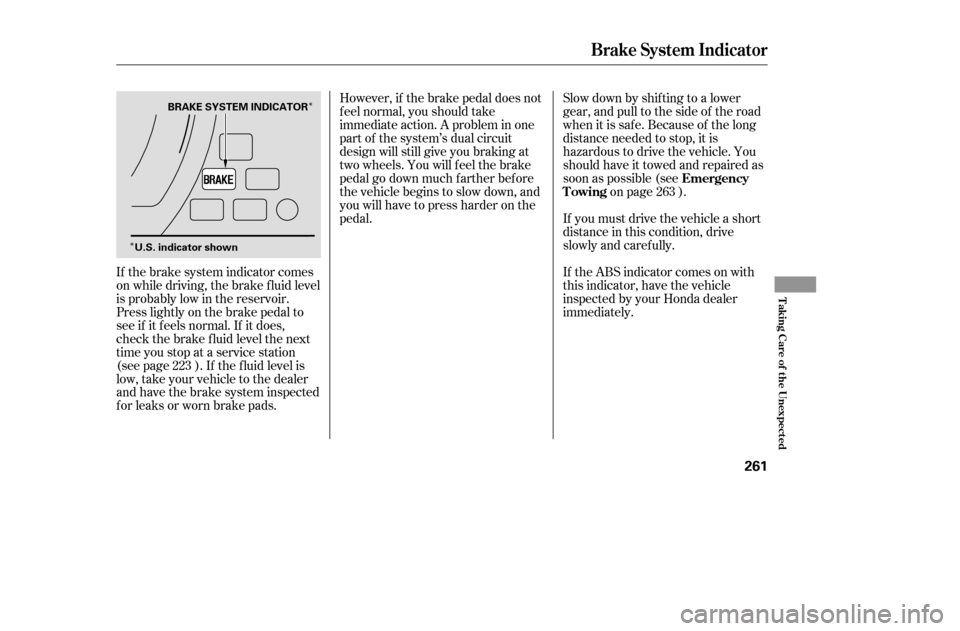Page 242 of 289

Turn the ignition switch to START
(III). If the headlights do not dim,
check the condition of the f uses. If
thefusesareOK,thereis
probably something wrong with
the electrical circuit f or the
ignition switch or starter motor.
You will need a qualif ied
technician to determine the
problem (see
on page ).In this case, the starter motor’s
speed sounds normal, or even f aster
than normal, when you turn the
ignition switch to START (III), but
the engine does not run.
Are you using the proper starting
procedure? Ref er to on page .
Are you using a properly coded
key? An improperly coded key will
cause the immobilizer system
indicator in the instrument panel
to blink rapidly (see page ). Do you have f uel? Check the f uel
gauge; the low f uel indicator may
not be working.
There may be an electrical
problem, such as no power to the
f uel pump. Check all the f uses
(see page ).
If youfindnothingwrong,youwill
need a qualif ied technician to f ind
the problem. See on page .
If the headlights dim noticeably or
go out when you try to start the
engine, either the battery is dis-
charged or the connections are
corroded. Check the condition of
the battery connections (see page
). You can then try jump
starting the vehicle from a booster
battery (see page ). 265
263 175
77 263
242 253
If theEngineWon’tStart
Emergency T owing T he Starter Operates Normally
Starting the
Engine
Emergency
Towing
252
�����—�����—�����y�
�������������y���
�(�����������y���������y
Page 243 of 289

Open the hood, and check the
physical condition of the battery.
In very cold weather, check the
condition of the electrolyte. If it
seems slushy or f rozen, do not try
jump starting until it thaws.
To jump start your vehicle:
You cannot start your vehicle by
pushing or pulling it. The numbers in the illustration show
the order to connect the jumper
cable.
1.
CONT INUED
Jump St art ing
T aking Care of t he Unexpect ed
253
BOOSTER
BATTERY
4-cylinder models
A battery can explode if you do
not follow the correct procedure,
seriously injuring anyonenearby.
Keep all sparks, open flames,
and smoking materials away
from the battery. If a battery sits in extreme
cold, the electrolyte inside can f reeze.
Attempting to jump start with a f rozen
battery can cause it to rupture.
�����—�����—�����y�
�����������
�y���
�(�����������y���������y
Although this seems like a simple
procedure, you should take several
precautions.
2.Turn of f all the electrical acces-
sories: heater, A/C, climate
control, stereo system, lights, etc.
Put the transmission in Neutral
(M/T) or Park (A/T), and set the
parking brake.
Page 251 of 289

�Î
�ÎHowever, if the brake pedal does not
f eel normal, you should take
immediate action. A problem in one
part of the system’s dual circuit
design will still give you braking at
two wheels. You will f eel the brake
pedal go down much f arther bef ore
the vehicle begins to slow down, and
you will have to press harder on the
pedal. If the ABS indicator comes on with
this indicator, have the vehicle
inspected by your Honda dealer
immediately.
If the brake system indicator comes
on while driving, the brake f luid level
is probably low in the reservoir.
Press lightly on the brake pedal to
see if it f eels normal. If it does,
check the brake f luid level the next
time you stop at a service station
(see page ). If the f luid level is
low, take your vehicle to the dealer
and have the brake system inspected
for leaks or worn brake pads. If you must drive the vehicle a short
distance in this condition, drive
slowly and caref ully.
Slow down by shif ting to a lower
gear, and pull to the side of the road
when it is saf e. Because of the long
distance needed to stop, it is
hazardous to drive the vehicle. You
should have it towed and repaired as
soon as possible (see
on page ).
223 263
Emergency
Towing
Brake System Indicator
T aking Care of t he Unexpect ed
261
BRAKE SYSTEM INDICATOR
U.S. indicator shown
�����—�����—�����y�
�������������y���
�(�����������y���������y
Page 255 of 289
The interior f use box is on the
driver’s lower lef t side. To remove
the f use box lid, pull it toward you
and take it out of its hinges.The under-hood f use box is located
near the back of the engine compart-
ment on the driver’s side. To open it,
pushthetabsasshown.If something electrical in your
vehicle stops working, the first thing
youshouldcheckforisablownfuse.
Determine f rom the chart on pages
and , or the diagram on the
f use box lid, which f use or f uses
control that component. Check those
f uses f irst, but check all the f uses
bef ore deciding that a blown f use is
not the cause. Replace any blown
f uses and check if the device works.
Turn the ignition switch to LOCK
(0). Make sure the headlights and
all other accessories are of f .
Remove the cover f rom the f use
box.
1. 2.
268 269
CONT INUED
Fuses
Checking and Replacing Fuses
T aking Care of t he Unexpect ed
265
INTERIOR
UNDER-HOOD
TAB
�����—�����—�����y�
���������
���y���
�(�����������y���������y
Page 258 of 289
�µ�µ
�Î �Î �Î
�´
�Î
No. Amps. Circuits Protected No. Amps. Circuits Protected No. Amps. Circuits Protected
: 6-cylinder models
1 2345 10 A
(30A) 10 A
15 A
10 A Left Headlight Low
(Rear Defroster Coil)
Lef t Headlight Hi
Small Light
Right Headlight Hi 6789
10 10 A
7.5 A 15 A
20 A Right Headlight Low
Back Up
FI ECU
Condenser f an
Not Used 111112131415161717181819202122 23
20 A
30 A
7.5 A
20 A
40 A
40 A
15 A
30 A
30 A
20 A
40 A
40 A
(40 A) 40 A
100 A
50 A
50 A Cooling Fan
Cooling Fan
MG. Clutch
Horn, Stop
Rear Defroster
Back Up, ACC
Hazard
ABS Motor
TCS Motor
ABS F/S
TCS
Ignition Coil, DRL (Canada)
Power Seats, Seat Heaters
Heater Motor
Battery
Not Used
BIG1Main
Power Window Main
Fuses
268
UNDER-HOOD FUSE/RELAY BOX
�����—�����—�����y�
�����������
�y���
�(�����������y�������
�y
Page 259 of 289

�µ�µ �µ
�Î �Î
�Π�ΠNo.No.
Amps. Amps.Amps.
Circuits Protected Circuits Protected
No. Circuits Protected 1 : 6-cylinder models
2 : On Canadian models
789
101112 131415161718192021222324252627282930313233
(15 A)
15 A
(10 A)
15 A
10 A
7.5 A 10 A
20 A
15 A
7.5 A 30 A (20 A)
(20 A)
(20 A)
(20 A)
(20 A)
15 A
15 A
7.5 A
7.5 A 10 A
7.5 A 20 A
20 A
20 A
20 A
(20 A)
7.5 A
7.5 A
7.5 A
Back-Up Lights
Door Lock
Front Accessory Sockets
IG OPDS
IG Wiper
Not Used Driver’s Power Seat Slide
Heated Seat
Driver’s Power Seat Recline
IG ACG
IG Fuel Pump
IG Washer
IG Meter
IG SRS
IGP (PGM-FI ECU)
Lef t Rear Power Window
Right Rear Power Window
Right Front Power Window
Driver’s Power Window
Moonroof
Not Used
IG HAC
Not Used
ACC
HAC OP
123456
DrivebyWire
Ignition Coil
Day Light
Laf Heater
Radio
Interior Light
Passenger’s Power Seat Recline
Passenger’s Power Seat Slide
1 2
Fuses
T aking Care of t he Unexpect ed
269
INTERIOR FUSE BOX
�����—�����—�����y�
�������������y���
�(�����������y���������y
Page 264 of 289

�µ
�µ �µ�µ �µ �µ�µ�µ�µ�µ�µ�µ�µ�µ�µ�µ �µ �µ
�Î�Î
�Î�Î�Î
�Î�Î �Î�Î�Î
�Î
�Î�Î
�Î�Î �Î�Î
�Î�Î �Î�Î
CONT INUED
Specif ications
T echnical Inf ormation
275
Lights
Fuses
Battery Engine
Alignment
3.43 x 3.9 in (87.0 x 99.0 mm)
143.6 cu-in (2,354 cm
)
12 V 60 W (HB3)
12 V 51 W (HB4)
12 V 24/2.2 CP
9.7 : 1
3.39 x 3.39 in (86.0 x 86.0 mm)
182.8 cu-in (2,997 cm)
10 : 1
12 V
12 V
12 V
12 V
12 V
12 V
12 V 21 W
21/5 W
2CP
21 W
21 W
3CP8W
52 AH/5 HR
38 AH/5 HR
12 V
12 V
12 V
12 V
12 V
1.1 W
2CP
5W
8W8W
12 V
12 V
Headlights
Front turn signal/
Front parking lights
Rear turn signal lights
Stop/Taillights
Taillights
High-mount brake light
Back-up lights
License plate light
Ceiling light
Spotlights
Spotlights/Front ceiling lights
Trunk light
Door courtesy light
Vanity mirror lights
Interior
Under-hood
Capacity Type
BorexStroke
Displacement
Compression ratio
Spark plugs
Water cooled 4-stroke, DOHC
i-VTEC 4-cylinder, SOHC VTEC
6-cylinder (V6), gasoline engine
Toe-in
Camber
Caster 3°15’1°
0°
0.08 in (2.0 mm)
0.00 in (0.0 mm) IZFR6K-13 SKJ20DR-M13
SKJ20DR-M11
IZFR6K-11
See page 269 or the fuse label
attached to the inside of the fuse
box door on each side of the
dashboard.
See page 268 or the fuse box
cover. FrontRear
FrontRear
Front
HighLow
4-cylinder
6-cylinder
1: LX
2: EX (Amber)
3 : 4-cylinder models
4 : 6-cylinder models
5 : On some models NGK:
DENSO:NGK:
DENSO:
12
343
4
34
3, 4 3, 4
3, 5 3, 5
�����—�����—�����y�
�������������y���
�(�����������y���������y
Page 271 of 289

�Î
�ÎThe burning of gasoline in your
vehicle’s engine produces several by-
products. Some of these are carbon
monoxide (CO), oxides of nitrogen
(NOx) and hydrocarbons (HC).
Gasoline evaporating f rom the tank
also produces hydrocarbons. Con-
trolling the production of NOx, CO,
and HC is important to the environ-
ment. Under certain conditions of
sunlight and climate, NOx and HC
react to f orm photochemical ‘‘smog.’’
Carbon monoxide does not contri-
bute to smog creation, but it is a
poisonous gas. The United States Clean Air Act
sets standards f or automobile
emissions. It also requires that
automobile manufacturers explain to
owners how their emissions controls
workandwhattodotomaintain
them. This section summarizes how
the emissions controls work.
In Canada, Honda vehicles comply
with the Canadian emission
requirements, as specif ied in an
agreement with Environment
Canada, at the time they are
manuf actured.
Your vehicle has a positive
crankcase ventilation system. This
keeps gasses that build up in the
engine’s crankcase f rom going into
the atmosphere. The positive
crankcase ventilation valve routes
them from the crankcase back to the intake manif old. They are then
drawn into the engine and burned.
As gasoline evaporates in the f uel
tank, an evaporative emissions
control canister f illed with charcoal
adsorbs the vapor. It is stored in this
canister while the engine is of f . Af ter
the engine is started and warmed up,
the vapor is drawn into the engine
and burned during driving.
The onboard ref ueling vapor
recovery (ORVR) system captures
the f uel vapors during ref ueling. The
vapors are adsorbed in a canister
f illed with activated carbon. While
driving, the f uel vapors are drawn
into the engine and burned of f .
Emissions Cont rols
The Clean Air Act
Crankcase Emissions Control
System
Evaporative Emissions Control
System
Onboard Ref ueling Vapor
Recovery
282
�����—�����—�����y�
�������������y���
�(�����������y���������y